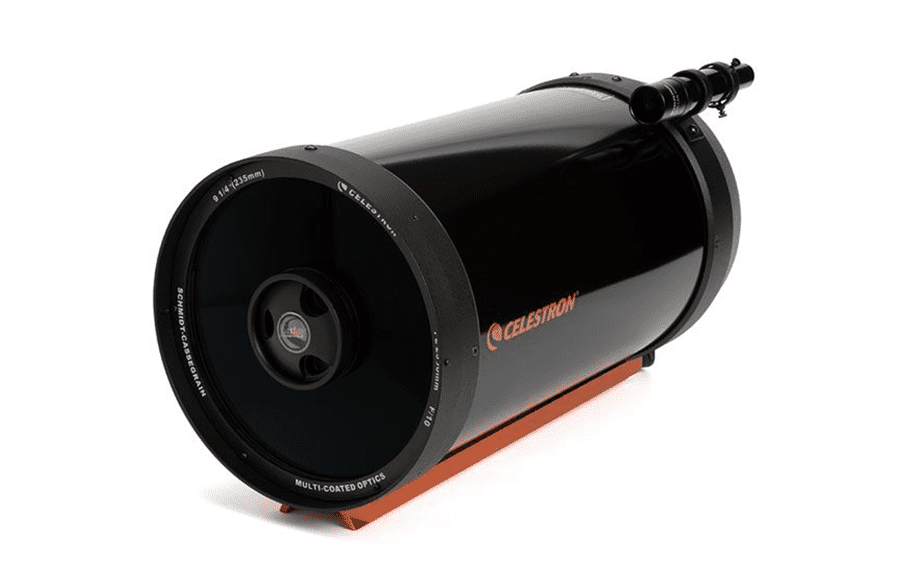If you are looking for the next step up from your entry-level telescope, or you just want to start out with something which won’t need upgrading for a very long time, The Celestron C9.25 XLT with Starbright coatings (C925), may well be for you.
The C925 can be found everywhere from back gardens and sheds, to full scale observatories, so it is very much a proper grown-up telescope, at a relatively modest price for what it offers.
The C925 I will be reviewing here is known as an optical tube assembly (OTA). It’s the actual part of the telescope which contains the optics, but does not include a mount or tripod. We will discuss these elements later on.
So why would anyone buy the optics just on their own? Well you may already have a very nice mount and tripod and you simply need a better telescope. Or you may want to have the choice of more than one OTA – say a short refractor for deep sky imaging and the C925 for planetary observations.
In this review then I will set up the C925 on my own mount and tell you a bit about the OTA design, outline its features and specifications and I’ll give you my opinions on some of its pros and cons.
I’ll touch upon how to image (take photos!) with the OTA, show you some that I have taken with it and I’ll also describe some examples of the various different mounting options available. I’ll also mention possible alternative OTA’s you may want to consider.
If all that sounds like information you’d like to arm yourself with, then read on!
Contents
Celestron C9.25XLT OTA
FEATURES: f/10 focal ratio, 2350mm focal length, StarBright XLT optical coating, and 555x highest magnification
BENEFITS
- The ‘Folded light’ optics of the Schmidt Cassegrain design allows for a long focal length to be squeezed into a relatively compact, easily handled tube. Considering the OTA weighs over 9kg, I found it very easy to handle. The provision of the built-in carry handle really helps here. So if you are not lucky enough to be able to keep your telescope setup permanently, it’s not a major hassle to lift OTA onto and off of the mount.
- Extremely versatile OTA with the potential for use at three different focal lengths - it can be used for planetary and deepsky as a visual astronomy scope and as the foundation of a great astrophotography setup.
- Removable screws around the circumference of the tube allows finder-scopes, guidescopes, piggy-backed telescopes and photography equipment to be securely mounted on board. Although it maxed out my mount’s payload capacity, I even managed to securely mount a 4kg 102mm refractor onto the tube!
- Starbright XLT optical coatings offer 16% improvement in light transmission compared to previous Starbright coatings. This allows for brighter, more detailed views when observing and shorter exposure times when imaging.
What We Like
- It’s as compact as you will ever get for this focal length. By comparison my old Newtonian Reflector has a focal length of 1200mm and the physical length of the tube is 1400mm, yet with a focal length of 2350 the c925 is merely a stubby 559mm in physical length – almost a quarter of the length it would be without the clever schmidt cassegrain light-folding design
achieve . - You can add a wide variety of finder scopes, guidescopes, piggy-back cameras etc onto the tube. I loaded a Skywatcher 102 onto this OTA – it weighs nearly 4kg and there is not the slightest indication of tube deformation or a feeling that you may be damaging it.
- Silky smooth focusing mechanism with no slack – you really would not know that you are moving a heavy mirror !
- Closed tube (but not sealed) means that the mirror and internal optics stay clean and dust-free. If you are used to reflector-style telescope dust-buckets this will be a revelation!
What We Don’t Like
- There really is very little to dislike about this OTA. If I was being picky I would perhaps mention that despite a generally very high build quality standard, my copy had an unevenly wrapped rubber grip around the focus knob. This gives the effect of the knob wobbling as it turns (it doesn’t).
- Be aware also that the corrector plate is very close to the end of the tube so it is very easy to touch accidentally (never touch a lens surface!). Most users will however add a dew shield of some sort.
- As lovely as the focusing is on the c925 I would perhaps like the gearing to allow slightly finer focus. At high powers it only takes the slightest touch to de-focus. If you use an auto-focuser this will not be an issue.
- And, if like me you are used to the star diffraction spikes that all reflector-based designs produce, you may well miss that in your images using an SCT (there are ways to reproduce the effect with 2 pieces of thread though..)
- The tube does need careful storage if you live in a damp climate- with a design which is half-way between being fully open and being sealed, moisture can get trapped and cause mold. I suggest use of a desiccant cap when the tube is not in use.
How The C925 Compares to Similar Products
Celestron is not of course the only manufacturer to utilize designs which ‘fold’ light into a short tube. Notable alternatives you may want to consider include;
Celestron’s own Edge version of the C925. Adds air vents for faster temperature balance, mirror lock for maintaining focus and built-in field flattener for sharp round stars right to the very edge of the field of view. Great for photographing deepsky – galaxies and nebula. Removes; around $1000 from your wallet. Typical price $3000
Skywatcher Skymax 180 Pro. If the price of the C925 is a little too rich for your blood, this alternative from Skywatcher may fit the bill. It has a slightly smaller mirror (180mm) but an astonishing F ratio of F15 and 2700mm fl.
This means it’s a very ‘slow’ telescope ideal for planetary work.So being specialized for high magnification requirements it will not be very satisfactory with all but the very brightest deepsky objects. Typical price $1300-$1500
Ioptron RC 8” Richey-Chretien OTA. Also a little cheaper than the C925 this very similar looking OTA actually has a different optical design which allows for coma, spherical and chromatic aberration-free images without any additional accessories.
A dual-speed focuser also sweetens this 200mm (8inch), F8 /1624mm deal ! Another product which will be amazing for planetary and galaxies, but less so for deepsky objects like nebula. Typical price $1200
StellaLyra 10″ f/12 M-LRC Classical Cassegrain Carbon Truss Telescope OTA. More expensive than the C925 but this really is a design which stands out. 10inch F12 with an open tube design that allows very good temperature stability. Fixed position mirror. Another one for lunar and planetary imaging. Typical price $3200
The Optical Tube Assembly
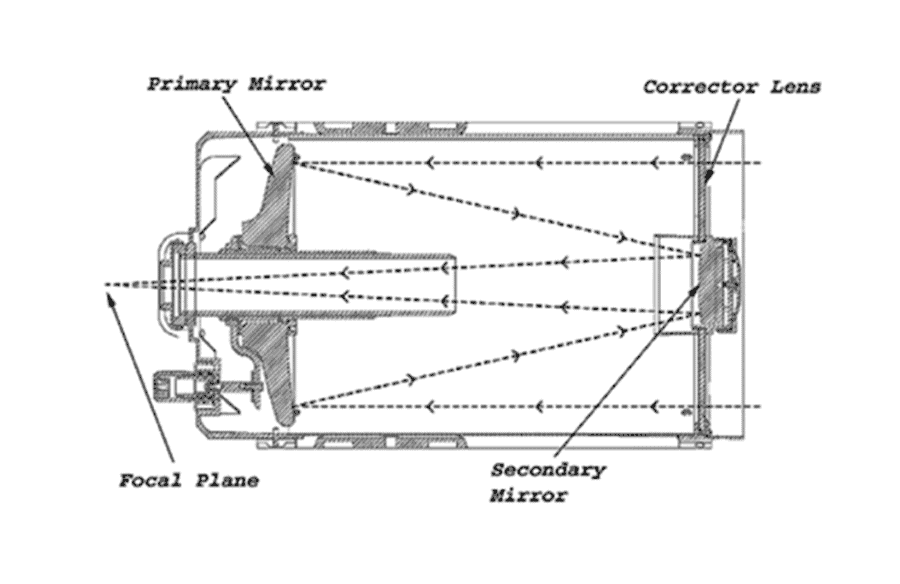
The Celestron C925 OTA has a long history; it has been around in some form since the mid-90’s and other sizes in the range including 8 and 12inch date back to the 1970’s! So although there have been minor changes to its external finish over the years, this is very much a tried and tested design.
It employs the Schmidt Cassegrain design which is illustrated above. Focus is achieved by moving the primary mirror itself. Light is bounced off several lenses to increase the focal length otherwise achievable in a tube of its physical length.
XLT is the latest version of Celestron’s star bright coatings which have been used in some form as far back as 1984. Another more recent addition to this OTA is fastar/hyperstar compatibility.
There is not much else to see on the outside of the tube- a focus knob, a carry handle and a finderscope completes the roster.
The main reason many people love this OTA is for its versatility. If you are firmly a deepsky enthusiast, or you only ever photograph planets then the choice of telescope you buy for each of these interests is fairly straightforward.
But if, like me, you want to be able to do all kinds of astronomy with one OTA, then this is where the C925 comes into its own.
Out of the box with the supplied accessories this is a telescope best suited to planetary observing. Deepsky objects of a decent brightness that fit in its field of view can also be viewed or photographed in this native mode. Objects with a similar scale to M51, the bubble nebula and many globular clusters all look fantastic at 2350mm.
With a Celestron f/6.3 focal reducer the C925 is reduced to F6 with a focal length of around 1480mm. This makes it good for a wide range of deep sky objects. It reduces required exposure times by a factor of 3, gives a wider field of view and also corrects edge distortions to give a flatter field. With the focal reducer in play, guiding and focussing also become easier.
Finally when used with a hyperstar, the C925 becomes an F2, 400mm focal length light-monster with 25x the light gathering power. You’ll seldom need longer exposure times than 30 seconds and you won’t even need to guide (depending on the accuracy of your mount). You will also build up an impressive library of ‘bagged’ targets, which would otherwise take you… well 25x as long to build up!
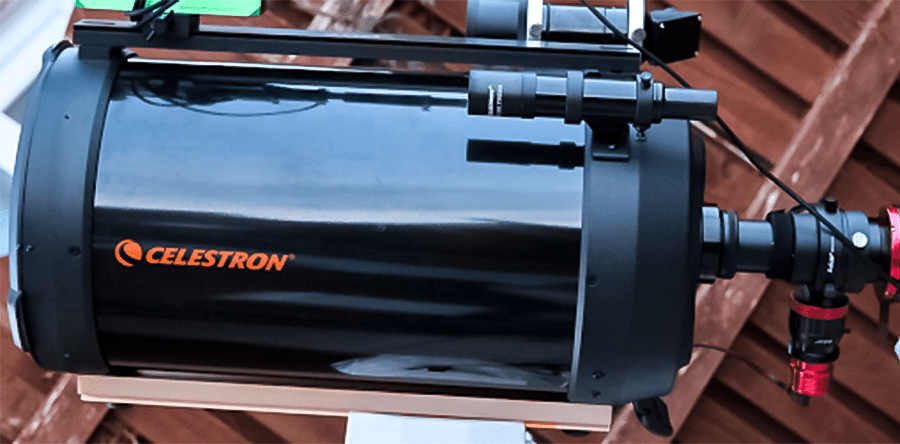
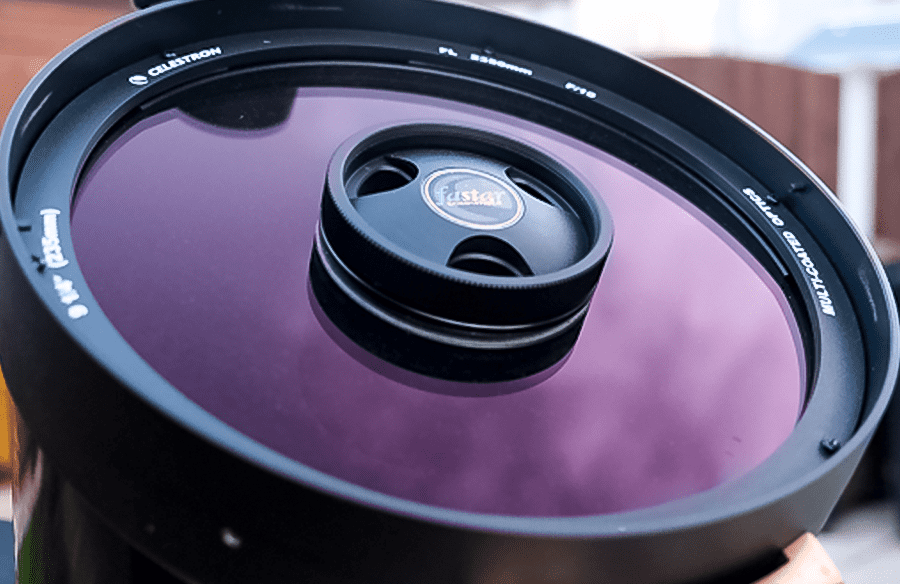
The Scope’s Accessories
In the box the following was supplied.
- The OTA itself
- 25mm eyepiece
- 6×30 finderscope
- Visual back adapter system including star diagonal
- CGE/Losmandy style dovetail for attachment to the mount
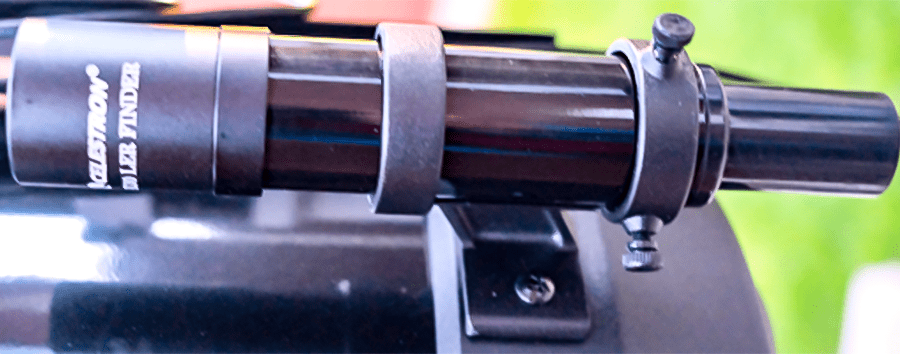
In terms of third party accessories I would have to triple the length of this review to list and describe a fraction of what’s available (and I already get into trouble for the length of my articles). I would recommend perusal of your local astronomy website or shop for the accessory you require.
However one popular accessory is called ‘Bob’s Knobs’ which makes collimation easier and less liable to damage the corrector plate from slipped tools. The collimation screws which the knobs slip over are positioned in the middle of the corrector plate.
I would also highly recommend an electronic automatic focuser (EAF) if you plan on deepsky astrophotography. Focus can drift as temperature changes or when you move to a new target.
Fastar/Hyperstar
Co-developed by Celestron and Santa Barbara Instruments Group in the late 90’s this astonishing little lens system replaces the secondary mirror and any photographic attachments at the back of the scope. It sits in the middle of the corrector plate at the front of the tube!
Once a camera is connected the C925 becomes an extremely fast (F2.2), wide-field imaging scope, reducing exposure times by around 25x. The claim (not yet tested by myself) is that the swap from native F10 to F2.2 and back again can take place in minutes, without affecting collimation.
Unboxing
Arguably the best part of a reviewer’s day! Very simply packaged, the C925 arrived safely from its long journey to the UK, from China via the US.
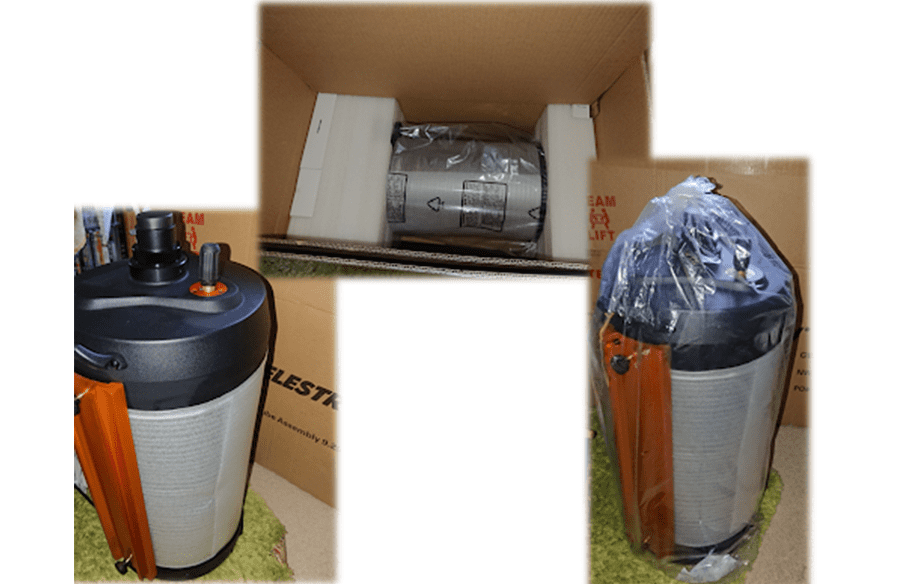
Celestron C9.25XLT Specs
Imaging with the 9.25XLT
As supplied, the C925 works best as a planetary observing telescope. The gas giants fill a good chunk of the field of view and you will easily be able to see the Cassini division of Saturn’s rings and the equatorial belts of Jupiter. Mars’ polar ice caps will also be visible.
The moon will fit nicely in the field of view at 94x magnification with the supplied 25mm Plossl eyepiece. See images further down for how the moon looks when photographed at F10
So now onto astrophotography. You may need to open your wallet again for the appropriate adapters and accessories if your astronomy cupboard doesn’t already have something suitable.
To image with the C925 simply unscrew the visual back and screw in your photo equipment. All camera equipment screws onto the end of the ‘bottom’ end telescope tube – unlike a reflector telescope where the eyepieces and camera equipment are placed at the side,
Using a dedicated astro-cam
For testing purposes I used an astrocam – a dedicated astronomical camera. If you are new to the concept, an astrocam looks essentially like a button-less metal cylinder, with data and power connections at one end.
Astrocams are usually coloured bright red, blue and even pink for some reason. No buttons or lenses are required because the telescope optics is the lens and everything is controlled from the computer (or phone).
Using a DSLR or mirrorless
Of course you may be using an SLR, mirrorless or even a phone to take photos through the C925, but the practicalities of me testing each of these separately with the rare periods of clear sky I am blessed with, are against me. The principle will however be the same, albeit with different rings and adapter tubes to allow your particular setup to achieve focus.
The main difference using DSLR/mirrorless is that you do most of the controlling of the photography side of things from the camera itself. As you will be touching the camera and telescope you do run the risk of knocking out alignment and focus as you make adjustments.
However if you use Canon or Nikon DSLR’s a lot of astrophotography software will directly control the camera from your PC just like an astrocam. No such luck for Fujifilm users I’m afraid. Presumably through lack of demand, nobody has yet written the required drivers for fuji to speak to astro software (ASCOM-based mainly).
So how did I find imaging with the C925?
I used a Bhatinov mask to check my focus on a bright star before imaging and then attached a dew shield. Not only to prevent dew, but also to better shield from nearby street lights. Overall I was very happy with the image quality I was seeing on my laptop screen.
Below then is a selection of some of my better results taken with a ZWO ASI294MC (one-shot-color) astrocam, guided by a ZWO 120mm mini mono camera. The Bubble Nebula, Dumbbell Nebula and The Whirlpool Galaxy were taken with the 0.63x focal reducer. M3 globular cluster and the moon were taken at 2350mm F10.
I wish I could show you images of Jupiter, Saturn and Mars taken with the C925 – these planets are after all what the C925 is best suited to imaging. However at the time of writing this review no planets (and very little darkness!) were available where I am! I hope to update the review later in the year with planetary photos.
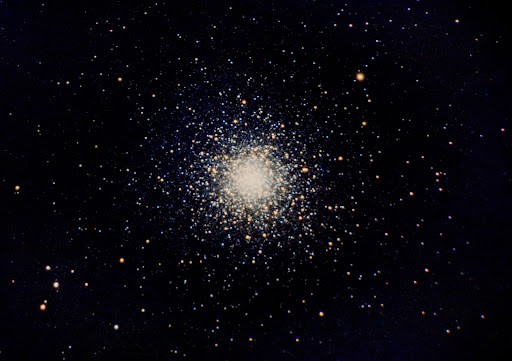
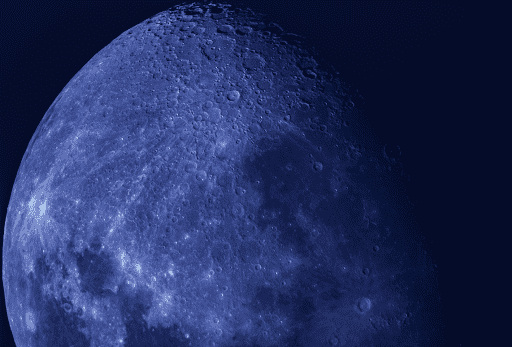
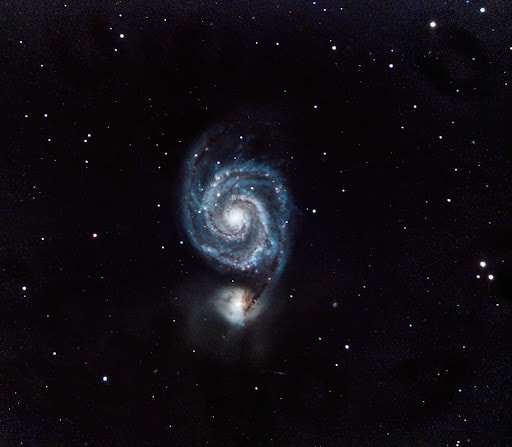
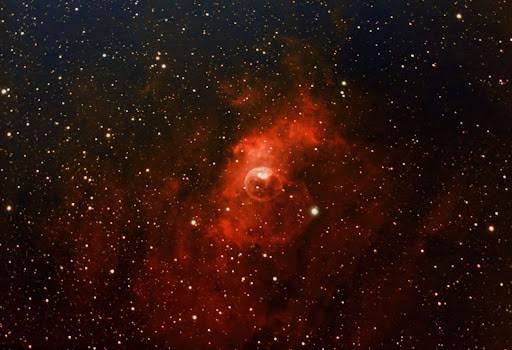
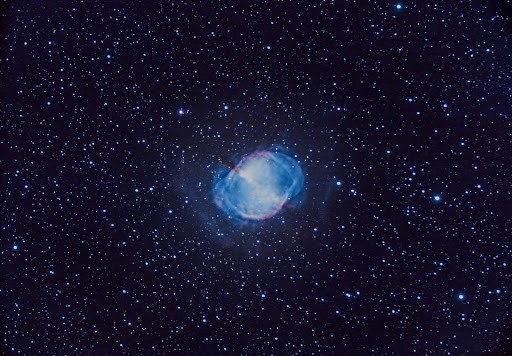
Mounting Options
Celestron does ship the C925 with a variety of mounts or just the OTA on its own, but everyone’s budget, available space and astronomical goals are different. If Celestron’s own default mounting options do not suit you then, you are of course free to sit the OTA on whatever mount you want.
You may therefore want to consider the following mounting options for the C925.
Skywatcher AZ-EQ6 GT Pro. This is a dual-purpose, heavy-duty mount with 18kg/25kg photographic/visual payload capacity. If you are using your C925 primarily for visual, the Alt-Azimuth mode may suit you better than EQ mode..
Being a multi-purpose mount it’s also helpful if you want to be able to swap the C925 out for another OTA for terrestrial use. In EQ mode it is similar to the EQ6-r mount which is cheaper and also a good option of you will only be using it in EQ mode. However be aware that this mount costs as much as the OTA and is very heavy! Typical price $2000-2500
Celestron’s own Advanced VX Mount. You may want to keep with Celestron, in which case this mount matches the C925 aesthetically. Much less expensive and with a lower payload capacity than the Skywatcher (around 13kg), this mount will still work well with the OTA and have capacity for accessories. High torque motors, periodic error (permanent) training and large ergonomic controls should make this mount accurate and a pleasure to use-Typical price $1100-1500
Explore Scientific EXOS-2 PMC-8 GOTO. If you’re looking to keep costs down and you have no intention of adding heavy accessories and camera equipment (such as a DSLR) to your C925, this mount will do very nicely. Can be controlled from your phone including location finding via phone GPS.
No hand controller is required and it’s designed to work on mains or batteries. Good option if you want to keep your kit portable. Belt driven stepper motors and military grade 8CPU hardware are just a fraction of this device’s impressive roster of features! Typical Price $600-1000
Final Thoughts on the C925
The best thing about the C9.25XLT, in my opinion, is that it can be 3 telescopes in one, offering the best-of-all-worlds (with additional expenditure) that is very rare in the world of telescopes.
It is superb for planetary observation and photography at its native 2350mm FL f10. Deepsky works out nicely with a focal reducer, or you can go for very bright, widefield images with a Fastar attachment.
However, even if you only ever use it as supplied you will have an amazing planetary scope which will show you views of the larger planets that typically only NASA and very well-off private individuals could produce a few decades ago.
The telescope design does leave the corrector plate prone to stray fingerprints and I would like slightly finer control over focus at the full 2350mm.
But those minor caveats aside – none of which are insurmountable, I and the rest of the team at Optical Mechanics can wholeheartedly recommend the Celestron C9.25XLT as amongst the best value and most versatile telescopes out there.

